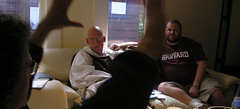Privacy and Architecture
Coffee yesterday evening with Kevin Bankston, an EFF lawyer, who was kind enough to brief me on Lessig and some current cases he's been working on. Kevin asked me for some books to read on the history of privacy, and I've decided to post the reply.
The best article remains the one that started me thinking, one in the annals of the american association of geographers by Michael Curry, a UCLA professor. He writes about property law and space in common law history, the protection of houses, churches, and hospitals in particular.
The most brilliant book I've ever read on privacy and the use of space: Paul Carter's Repressed Spaces. A haunting, beautiful, deep book, much about how urban planners think and how artists and philosophers handled space in the early 20th century, as we started to think of ourselves as Freudian creatures.
I'm looking at my bookshelf -- there are a lot of titles that were halfway useful but didn't make me reconsider the nature of the beast entirely. Miles Ogborn's Spaces of Modernity is a study of 18th c London that typifies the straight-out-of-foucualt school. Sisella Bok's Secrets is more interesting for the uses of privacy (it's also older). Two books that are really good on historical reasons to contain information (bnut have nothing to do with buildings) are Roy Porter's Trust in Numbers and David Vincent's Culture of Secrecy.
When I was working on the topic, I guess I ended up writing a series of articles about class interaction and buildings -- when the elite ran away and started building pleasure palaces on the rhine valley; when the middle class started feeling like they needed to curtain in their coffee house booths -- it all has to do with rising levels of class conflict on the public street. which is one reason i'm now writing about the roads, and how they change the dynamics inside a town when they arrive: they necessarily make public and noticeable the kinds of social tensions brought in by changes in information flow and hierarchy.










0 Comments:
Post a Comment
<< Home